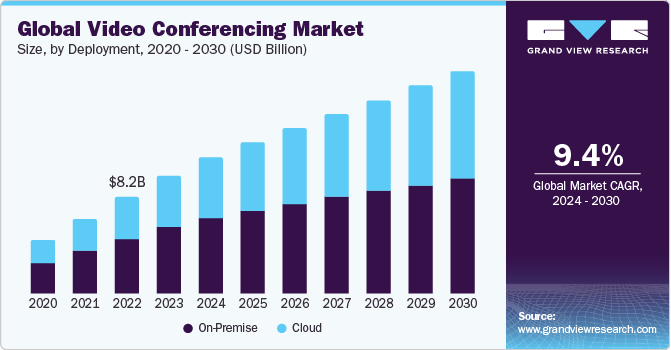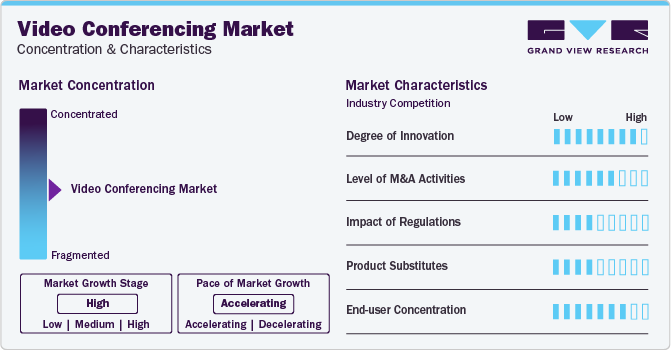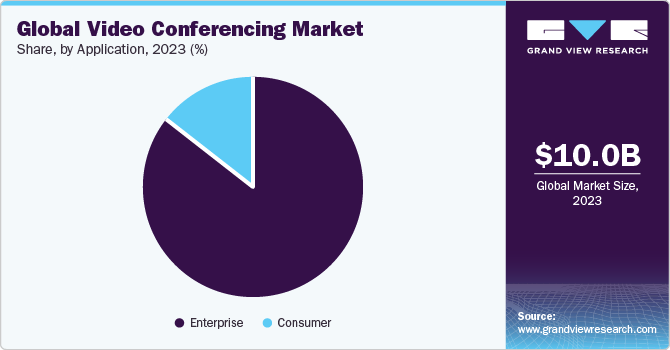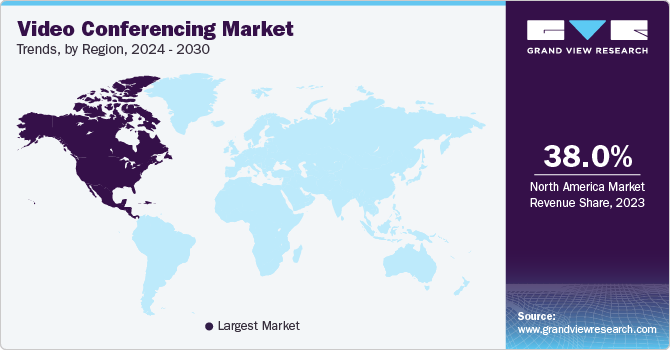
Video Conferencing Market Size, Share & Trends Analysis Report By Component (Hardware, Software), By Deployment (On-premise, Cloud), By Enterprise Size, By Application, By End-use, By Region, And Segment Forecasts, 2024 - 2030
- Report ID: GVR-3-68038-081-1
- Number of Report Pages: 160
- Format: PDF
- Historical Range: 2018 - 2023
- Forecast Period: 2024 - 2030
- Industry: Technology
Video Conferencing Market Size & Trends
The global video conferencing market size was estimated at USD 10.03 billion in 2023 and is expected to grow at a CAGR of 9.4% from 2024 to 2030. The market growth is attributed to the growing emphasis on hybrid work models. Businesses are integrating both in-person and remote work setups, driving the need for seamless integration between physical and virtual meeting spaces. In addition, advancements in Artificial Intelligence (AI) and Machine Learning (ML) are enhancing video and audio quality, while features such as real-time language translation and virtual backgrounds are becoming more prevalent, thereby driving market growth.

Furthermore, the increasing connection of businesses worldwide due to globalization has fueled the demand for video conferencing solutions. Companies are engaging in cross-border collaborations, international meetings, and global partnerships, which led to real-time communication tools to become essential in the globally connected scenario. Video conferencing facilitates virtual interactions that exceed geographical boundaries, enabling organizations to conduct business seamlessly across the globe, thereby expected to fuel the market growth.
Moreover, rising e-learning platforms, distance education programs, and hybrid learning models, the demand for video conferencing solutions in the education sector is growing considerably. Video conferencing enables educators to conduct interactive lessons, host virtual seminars, and engage with students in real-time, thereby fueling the demand for video conferencing market.
Market Concentration & Characteristics
The market for video conferencing is witnessing a high degree of innovation, particularly with the integration of AI, ML, among others. Increasing penetration of technologies has brought various innovations in video conferencing and benefited developers to enhance the user experience of their products & expand their customer base across the globe.

The market is witnessing a significant impact of government regulations and policies as governments across the globe are setting regulatory frameworks for video conferencing companies. For instance, regulations related to data security and privacy, such as GDPR in Europe or HIPAA in the U.S., impose stringent requirements on how personal and sensitive information is handled during video conferencing sessions.
The market is also being influenced by the rising number of mergers & acquisition activities that help companies increase market share, expand the customer base, and strengthen product portfolios.
Product substitutes are having a considerable impact on the video conferencing market. The presence of substitutes increases competition within the market and the availability of substitutes can make customers more price-sensitive.
End-user concentration is high in the market, as several industry verticals are adopting video conferencing solutions to enhance communication and collaboration. Moreover, by eliminating the need for travel and associated expenses, video conferencing helps end-users save money and time.
Deployment Insights
The on-premise segment accounted for the largest revenue share of around 57% in 2023, driven by industries complying strict data security requirements, existing investments in IT infrastructure, and challenges pertaining with internet reliability, latency, and bandwidth. In addition, the segment growth is also propelled by the increased demand for flexible, scalable solutions for remote work, lower upfront costs, reduced maintenance needs, and advancements in cloud technology enhancing security and interoperability.
The cloud segment is expected to record the highest CAGR of over 10% from 2024 to 2030. The segment growth is attributed to the rising adoption of cloud-based video conferencing solutions across businesses as they offer flexible work environments and increase overall productivity. They also increase business scalability and reduce operational costs while improving collaboration among customers, partners, and suppliers. This, in turn, is driving the segmental growth further.
Component Insights
The hardware segment held the highest revenue share in 2023, owing to increasing adoption of endpoints, including laptops, smartphones, and desktops equipped with high-resolution cameras, speakers, and microphones. The shifting trend toward remote and hybrid work culture, particularly after the pandemic, has led to the rapid adoption of video conferencing solutions for team collaboration.
The software segment is estimated to register the highest growth rate from 2024 to 2030. The growth is attributed to the rising demand for software solutions, driven by features such as real-time communication, screen sharing, virtual backgrounds, enhanced collaboration, and productivity among organizations. Moreover, the proliferation of high-speed internet and widespread smartphone adoption are also increasing the demand for video conferencing software.
Enterprise Size Insights
The large enterprises segment accounted for the highest market share in 2023. The segment growth is attributed to the high adoption of video conferencing solutions among these enterprises for business communications across geographies. As a result, major market players are focusing on developing offerings that can cater to the needs of multinational enterprises. For instance, in August 2022, Barclays Bank PLC deployed Microsoft Teams as its preferred collaboration platform, enabling collaboration for more than 120,000 colleagues and service partners in key locations around the globe, leading to their increased demand.
The SMEs segment is anticipated to expand at the highest CAGR from 2024 to 2030. The segment growth is attributed to the growing realization of the significance of conferencing and collaboration, especially after the COVID-19 outbreak. Various market players are developing solutions that are cost-effective and suit the requirements of SMEs. For instance, Cisco Systems Inc. offers collaboration solutions such as Cisco Business Edition 7000 for small and mid-sized businesses. Such instance is contributing to the segmental growth in the coming years.
Application Insights
The enterprise segment accounted for the largest market share in 2023, owing to the higher demand for conference video endpoints that are room-based hardware solutions deployed and configured in meeting rooms. Moreover, these room-based hardware solutions facilitate flexible work arrangements, enabling employees to collaborate across different locations, which is expected to improve the segment outlook in the coming years.

The consumer segment is expected to register the highest CAGR from 2024 to 2030. The rising demand for consumer-grade solutions, especially during and after the pandemic, is contributing to segment growth. The rising trend of online learning has also boosted the demand for these solutions to conduct virtual classes, lectures, and workshops. Moreover, the increasing demand for remote medical consultations and follow-ups has resulted in the growing adoption of video conferencing solutions.
End-use Insights
The corporate segment accounted for the largest market share in 2023. The segment growth is attributed to the growing consumer interest in cloud-based communication and collaboration solutions. The growing number of geographically dispersed teams has boosted the use of cloud-based platforms for seamless data sharing, collaboration, and communication. These platforms allow remote teams to simplify business processes and manage projects of all sizes while increasing the organization’s overall productivity, leading to their increased demand.
The healthcare segment is expected to register a significant CAGR from 2024 to 2030. The growing trend of telemedicine, allowing medical practitioners to implement video conferencing solutions to provide medical advice, monitor patients, and discuss treatment plans virtually is expected to drive the segment growth. Moreover, healthcare institutions collaborate across regions and specialties wherein video conferencing facilitates multidisciplinary discussions, case reviews, and knowledge sharing among medical professionals. Such collaboration is driving the segmental growth in the coming years.
Regional Insights
The video conferencing market in North America accounted for the largest revenue share of over 38% in 2023. The strong presence of various major technology companies, such as Microsoft Corporation, Google LLC, Cisco Systems, Inc., etc., providing high-end collaboration tools is contributing to the market growth. The growing regional telecom sector is aided by government initiatives to encourage the expansion of 5G networks in the region, further driving the adoption of video conferencing tools.

U.S. Video Conferencing Market Trends
The U.S. video conferencing market is anticipated to grow at a CAGR of over 8% from 2024 to 2030, owing to government initiatives in the country. For instance, in April 2023, the U.S. government launched the Public Wireless Supply Chain Innovation Fund to invest USD 1.5 billion in the development of open and interoperable networks. This funding is aimed at strengthening the future of 5G and next-gen wireless technologies in the country by demonstrating the viability of new, open-architecture approaches to wireless networks.
Asia Pacific Video Conferencing Market Trends
The video conferencing market in Asia Pacific is expected to record the highest growth rate of around 11% from 2024 to 2030. The increasing demand for collaboration tools, such as Microsoft Teams, Slack, and Google Workspace, amid the ongoing trend of remote and hybrid working models, has opened up growth avenues for the regional market. Besides, the strategic initiatives by market players to collaborate with regional companies and telecom operators are also favoring market growth.
India video conferencing market is estimated to record a notable growth rate of over 12% from 2024 to 2030, owing to the ongoing rapid digital transformation in the country which is generating substantial demand for video conferencing tools that can streamline business operations and are cost-effective.
The video conferencing market in China is projected to grow at a CAGR of around 12% from 2024 to 2030, owing to the rapid economic growth and the increasing adoption of the latest technologies across domestic enterprises.
Japan video conferencing market is projected to grow at a CAGR of around 11% from 2024 to 2030 due to the increasing trend toward remote and hybrid working models across organizations, which necessitates reliable video conferencing platforms.
Europe Video Conferencing Market Trends
The video conferencing market in Europe accounted for a market share of around 25% in 2023 due to the rising demand for video conferencing tools driven by the growing internet users and the prevalence of remote and hybrid work environments in the region.
UK video conferencing market is projected to grow at a CAGR of over 9% from 2024 to 2030 due to factors such as improvements in internet speed, video quality, and user-friendly software that enhance the video conferencing experience in the country.
The video conferencing market in Germany is estimated to record a CAGR of around 10% from 2024 to 2030. The growing significance of video conferencing tools for virtual meetings, collaboration, and maintaining productivity across organizations is favoring market growth.
Middle East And Africa (MEA) Video Conferencing Market Trends
MEA video conferencing market is anticipated to grow at a significant CAGR of over 10% from 2024 to 2030. The market growth is being driven by the increasing demand for collaboration services driven by the increased adoption of remote working models in the region.
The video conferencing market in Saudi Arabia accounted for a considerable revenue share in 2023. This is attributed to the ongoing digital transformation in the country as businesses increasingly recognize the need to adopt modern communication and collaboration tools.
Key Video Conferencing Market Company Insights
Some of the key players operating in the market Adobe Inc., Cisco Systems, Inc., Huawei Technologies Co., Ltd., Google LLC
-
Adobe Inc. is a diversified multinational software solutions provider. The company’s solutions and services meet the needs of professionals, marketers, application developers, enterprises, and consumers by creating, managing, delivering, and optimizing content and experiences across multiple devices.
-
Avaya LLC. is a business communications company offering a wide range of services and software, including real-time video collaboration, unified communications, networking, contact centers, and related services, to companies of all sizes worldwide. The company operates through two business segments: products and solutions and services.
Vidyo, Inc. (now Enghouse Video), West Corporation (Intrado Life & Safety, Inc.), and AURA Presence, LLC are some of the emerging market participants in the video conferencing market.
-
Vidyo, Inc. is a global developer and provider of video conferencing solutions, offering error-resilient, high-definition, and multi-point video conferencing to both desktop and room system endpoints. The company’s video conferencing solutions include VidyoConnect, VidyoEngage, and VidyoCloud, which make provisions for real-time, high-quality collaboration amongst geographically dispersed teams and offices
-
Intrado Corporation, formerly known as West Corporation, is a network infrastructure and communication services provider. The company provides collaboration and conferencing services to various industries/sectors, such as consumer services, cable & satellite, education, financial services, healthcare, manufacturing, insurance, public safety, retail, technology, telecom, transportation & logistics, travel & hospitality, and utilities, among others.
Key Video Conferencing Companies:
The following are the leading companies in the video conferencing market. These companies collectively hold the largest market share and dictate industry trends.
- Adobe Inc.
- AURA Presence, LLC
- Avaya LLC
- Cisco Systems, Inc.
- Google LLC
- Huawei Technologies Co., Ltd.
- Logitech International S.A.
- Microsoft Corporation
- Plantronics, Inc. (acquired by HP Development Company, L.P.)
- Enghouse Video (formerly Vidyo, Inc.)
- West Corporation (Intrado Life & Safety, Inc.)
- Zoom Video Communications, Inc.
Recent Developments
-
In April 2024, Adobe Inc. launched the latest all-new Frame.io V4, a flexible, fast, and intuitive creative collaboration platform that streamlines and simplifies workflows across content creation and production.
-
In April 2024, Zoom Video Communications, Inc. announced the general availability of Zoom Workplace, the company’s AI-powered collaboration platform that includes new features to help users reimagine teamwork, facilitate connections, and improve productivity.
-
In March 2024, Microsoft Corporation and Oracle expanded their collaboration to meet the growing customer demand for Oracle DatabaseAzure worldwide. As part of this initiative, Oracle DatabaseAzure is expected to expand in five more regions, bringing the total planned multi-cloud availability footprint to 15 regions globally.
-
In March 2024, Cisco Systems Inc. signed a five-year portfolio agreement with BBVA to provide the latter with faster access to Cisco Systems Inc.’s comprehensive software and Customer Experience (CX) portfolio. The agreement covers solutions in collaboration, cybersecurity, data center, networking, and services.
-
In February 2024, Huawei Technologies Co., Ltd. signed a memorandum of understanding with the telecom operator “du” in the UAE. This deal will continue to support the digital UAE by building the 5G Advanced country project.
Video Conferencing Market Report Scope
|
Report Attribute |
Details |
|
Market size value in 2024 |
USD 11.65 billion |
|
Revenue forecast in 2030 |
USD 20.02 billion |
|
Growth rate |
CAGR of 9.4% from 2024 to 2030 |
|
Actual data |
2018 - 2023 |
|
Forecast period |
2024 - 2030 |
|
Report updated |
June 2024 |
|
Quantitative units |
Revenue in USD million and CAGR from 2024 to 2030 |
|
Report coverage |
Revenue forecast, company ranking, competitive landscape, growth factors, and trends |
|
Segments covered |
Component, deployment, enterprise size, application, end-use, region |
|
Regional scope |
North America; Europe; Asia Pacific; Latin America; Middle East & Africa (MEA) |
|
Country scope |
U.S.; Canada; Germany; UK; France; Italy; Spain; China; Japan; India; South Korea; Brazil; Mexico; Saudi Arabia; South Africa |
|
Key companies profiled |
Adobe Inc.; AURA Presence, LLC; Avaya LLC; Cisco Systems, Inc.; Google LLC; Huawei Technologies Co., Ltd.; Logitech International S.A.; Microsoft Corporation; Plantronics, Inc. (acquired by HP Development Company, L.P.); Enghouse Video (formerly Vidyo, Inc.); West Corporation (Intrado Life & Safety, Inc.); Zoom Video Communications, Inc. |
|
Customization scope |
Free report customization (equivalent up to 8 analysts working days) with purchase. Addition or alteration to country, regional & segment scope. |
|
Pricing and purchase options |
Avail customized purchase options to meet your exact research needs. Explore purchase options |
Global Video Conferencing Market Report Segmentation
This report forecasts and estimates revenue growth at the global, regional, and country levels along with analyzes the latest market trends and opportunities in each one of the sub-segments from 2018 to 2030. For this study, Grand View Research has further segmented the global video conferencing market report based on deployment, component, enterprise size, application, end-use, and region:
-
Deployment Outlook (Revenue, USD Million, 2018 - 2030)
-
On-premise
-
Cloud
-
-
Component Outlook (Revenue, USD Million, 2018 - 2030)
-
Hardware
-
Camera
-
Microphone/Headphone
-
Others
-
-
Software
-
Service
-
-
Enterprise Size Outlook (Revenue, USD Million, 2018 - 2030)
-
Large Enterprise
-
Small & Medium Enterprises (SMEs)
-
-
Application Outlook (Revenue, USD Million, 2018 - 2030)
-
Consumer
-
Enterprise
-
-
End-use Outlook (Revenue, USD Million, 2018 - 2030)
-
Corporate
-
Education
-
Healthcare
-
Government & Defense
-
BFSI
-
Media & Entertainment
-
Others
-
-
Regional Outlook (Revenue, USD Million, 2018 - 2030)
-
North America
-
U.S.
-
Canada
-
-
Europe
-
Germany
-
U.K.
-
France
-
Italy
-
Spain
-
-
Asia Pacific
-
Japan
-
China
-
India
-
South Korea
-
-
Latin America
-
Brazil
-
Mexico
-
-
Middle East and Africa (MEA)
-
Saudi Arabia
-
South Africa
-
-
Frequently Asked Questions About This Report
b. The global video conferencing market size was estimated at USD 10.03 billion in 2023 and is expected to reach USD 11.65 billion in 2024.
b. The global video conferencing market is expected to grow at a compound annual growth rate of 9.4% from 2024 to 2030 to reach USD 20.02 billion by 2030.
b. North America dominated the market for video conferencing in 2023 and acquired a revenue share of over 38%. The strong presence of various major technology companies, such as Microsoft Corporation, Google LLC, Cisco Systems, Inc., etc., providing high-end collaboration tools is contributing to the market growth.
b. Some key players operating in the video conferencing market include Adobe Inc.; Array Telepresence Inc.; Avaya Inc.; Cisco Systems, Inc.; Huawei Technologies Co., Ltd.; Logitech International S.A.; Microsoft Corporation; Plantronics, Inc.; Vidyo Inc.; and West Corporation.
b. Key factors that are driving the video conferencing market growth include the rapidly growing demand for video communication on account of the globalization of businesses, geographically scattered business operations, and remote workforce management.
We are committed towards customer satisfaction, and quality service.
"The quality of research they have done for us has been excellent."




